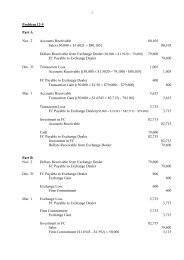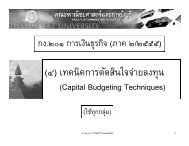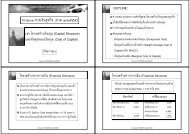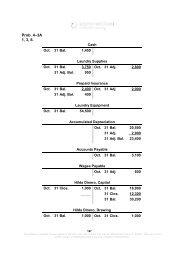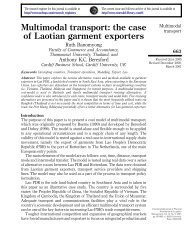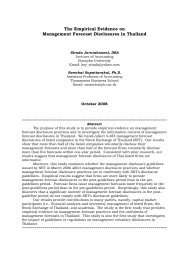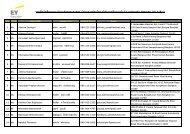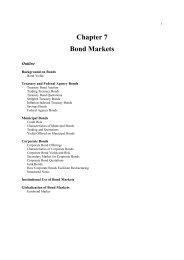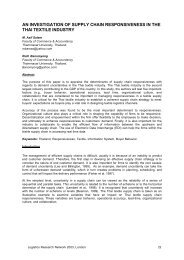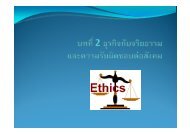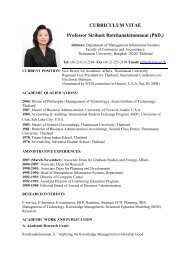Human capital and performance: A literature review
Human capital and performance: A literature review
Human capital and performance: A literature review
You also want an ePaper? Increase the reach of your titles
YUMPU automatically turns print PDFs into web optimized ePapers that Google loves.
individual decision about investment in education depends on unemployment among unskilled<br />
workers; the higher this is, the lower the return to work as a unskilled worker <strong>and</strong> the higher the<br />
incentive to invest in education.<br />
Gratton, L. & Ghoshal, S. (2003). Managing personal human <strong>capital</strong>: new ethos for the<br />
‘volunteer’ employee. European Management Journal, 21 (1) February, pp. 1-10.<br />
Due to the notion of democratization in the organization, a combination of individual autonomy in the<br />
work life <strong>and</strong> task variety leads to a greater personal responsibility for both developing <strong>and</strong> deploying<br />
their personal human <strong>capital</strong>. The authors define human <strong>capital</strong> as the composite of an individual’s<br />
intellectual, social <strong>and</strong> emotional <strong>capital</strong>s by which it is suggested that ‘volunteer’ employees need to<br />
align their personal values with work to reflect the most satisfying passions on a human aspiration,<br />
thereby continuously improving on one’s own knowledge, relationship <strong>and</strong> sense of self-efficacy.<br />
Huang, G. Z., Roy, M. H. & Ahmed, Z. U. (2002). Benchmarking the human <strong>capital</strong> strategies of<br />
MNCs in Singapore. Benchmarking An International Journal, 9 (4), pp. 357-373.<br />
This study aims to explore the role of human <strong>capital</strong> strategies in the survival <strong>and</strong> growth of promising<br />
local enterprises (PLEs) <strong>and</strong> existing multinational corporations (MNCs) in Singapore. The focus of<br />
the research aims to benchmark the human <strong>capital</strong> practices in the MNCs to the extent of whether<br />
PLEs are learning from the HR strategies of MNCs. The analysis draws on empirical data surveys<br />
from 218 PLEs <strong>and</strong> 261 MNCs through an extensive discussion on the issues of value of human<br />
<strong>capital</strong>, recruitment <strong>and</strong> selection, training <strong>and</strong> development, career management, corporate culture<br />
<strong>and</strong> government role. The results show substantial contrasts in the philosophical <strong>and</strong> practical<br />
applications of human resource strategies. More specifically, the conclusion of the study entails the<br />
fact that PLEs could learn from benchmarking the human <strong>capital</strong> strategies of the MNCs in the<br />
following arenas: modify philosophical underst<strong>and</strong>ing with regard to the importance of human <strong>capital</strong><br />
in creating a competitive advantage; develop different approaches to enhance the value of human<br />
<strong>capital</strong>, broaden the focus of selection <strong>and</strong> training methods to include critical thinking, teamwork <strong>and</strong><br />
leadership; <strong>and</strong> exp<strong>and</strong>ing a reward scheme, apart from extrinsic incentives, to help align<br />
organizational culture with new values of teamwork leadership <strong>and</strong> learning.<br />
Kannan, G. & Akhilesh, K. B. (2002). <strong>Human</strong> <strong>capital</strong> knowledge value added: a case study in<br />
infotech. Journal of Intellectual Capital, 3 (2), pp. 167-179.<br />
The paper addresses an essential need for managers to develop a behavioral tool to comprehend the<br />
factors that influence human <strong>capital</strong> knowledge value add so as to increase the organization value add.<br />
The proposed tool helps underst<strong>and</strong> the knowledge professional’s perceptions of the organization’s<br />
culture toward intellectual enterprise, knowledge management support systems <strong>and</strong> processes, <strong>and</strong><br />
individual value add, the perceived <strong>performance</strong>, innovation <strong>and</strong> consequences of quitting. The firm<br />
can move individuals to a more value-added position by giving them greater opportunities for<br />
knowledge sharing <strong>and</strong> capture, rewarding initiative, sharing <strong>and</strong> innovation as well as learning. Also,<br />
top management visibility <strong>and</strong> support, including increased leader involvement <strong>and</strong> guidance, can<br />
elevate feelings of belonging <strong>and</strong> importance to improve <strong>performance</strong> <strong>and</strong> the human <strong>capital</strong><br />
knowledge value added.<br />
LeBlanc, P. V., Mulvey, P. W. & Rich, J. T. (2000). Improving the return on human <strong>capital</strong>: new<br />
metrics. Compensation & Benefits Review, 32 (1) January/February, pp. 13-20.<br />
The article supports the use of the human <strong>capital</strong> approach to indicate the improvement of the return<br />
on human <strong>capital</strong>. By adopting such an approach, it means that the firms have to view their employees<br />
as an investment to be optimized rather than a cost to be minimized. <strong>Human</strong> <strong>capital</strong> is optimized when<br />
there is significant ‘knowledge,’ ‘motivation’ <strong>and</strong> ‘opportunity’ to perform. A six-step process of the<br />
human <strong>capital</strong> approach is introduced to help managers to make a better decision on the investment of<br />
the human <strong>capital</strong>. They are in a sequential order:<br />
<strong>Human</strong> <strong>capital</strong> <strong>and</strong> <strong>performance</strong> 31



